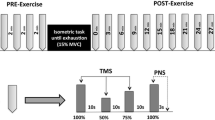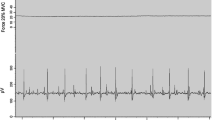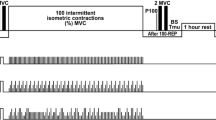Summary
Fatigue may be defined as a reduction in the maximal force-generating capacity of a muscle. It may result from peripheral processes distal to the neuromuscular junction and from central processes controlling the discharge rate of motoneurons. When assessed with a sensitive test using twitch interpolation, most “maximal” voluntary contractions approach but do not attain optimal muscle output. During fatigue, reflex inputs from intramuscular receptors may contribute to a decline in motor unit discharge rate — a decline which optimises force production during maximal efforts. Further studies should investigate how the central nervous system controls the discharge rate of motor units during fatigue produced by different forms of exercise.
Similar content being viewed by others
References
Belanger AY, McComas AJ. Extent of motor unit activation during effort. Journal of Applied Physiology 51: 1133–1135, 1981
Bellemare F, Woods JJ, Johansson R, Bigland-Ritchie B. Motor unit discharge rates in maximal voluntary contractions of three human muscles. Journal of Neurophysiology 58: 1380–1392, 1983
Bigland-Ritchie B, Furbush F, Gandevia SC, Thomas CK. Firing rates of motor units of human tibialis anterior at different muscle lengths. Journal of Physiology Proceedings 499: 33P, 1989
Bigland-Ritchie B, Cafaralli E, Vøllestad NK. Fatigue of submaximal static contractions. Acta Physiologica Scandinavica 128 (Suppl. 556): 136–148, 1986a
Bigland-Ritchie B, Dawson NJ, Johansson RS, Lippold OCJ. Reflex origin for the slowing of motoneurone firing rates in fatigue in human voluntary contractions. Journal of Physiology (London) 379: 451–459, 1986b
Bigland-Ritchie B, Johansson R, Lippold OJC, Woods JJ. Contractile speed and EMG changes during fatigue and sustained maximal voluntary contractions. Journal of Neurophysiology 50: 313–324, 1983
Bigland-Ritchie B, Jones DA, Woods JJ. Excitation frequency and muscle fatigue: electrical responses during human voluntary and stimulated contractions. Experimental Neurology 64: 414–427, 1979
Bigland-Ritchie B, Woods JJ. Changes in muscle contractile properties and neural control during human muscular fatigue. Muscle and Nerve 7: 691–699, 1984
Bigland-Ritchie B, Woods JJ, Furbush F, Karrmann D. Effect of muscle temperature on motor neuron MVC firing rates. Neuroscience Abstracts 12: 186.8, 1986c
Binder-Macleod SA, Clamman P. Force output of cat motor units stimulated with trains of linearly varying frequency. Journal of Neurophysiology 61: 208–217, 1989
Blimkie CJR, Sale DG, Bar-Or O. Voluntary strength, evoked twitch contractile properties and motor unit activation of knee extensors in obese and non-obese adolescent males. European Journal of Applied Physiology 61: 313–318, 1990
Bongiovanni LG, Hagbarth K-E. Tonic vibration reflexes elicited during fatigue from maximal voluntary contractions in man. Journal of Physiology (London) 423: 1–15, 1990
Burke RE, Rudomin P, Zajac FE. The effect of activation history on tension production by individual muscle units. Brain Research 109: 515–529, 1976
Cady EB, Elshove H, Jones DA, Moll A. The metabolic causes of slow relaxation in fatigued human skeletal muscle. Journal of Physiology (London) 418: 327–337, 1989
Cooper S, Eccles JC. The isometric responses of mammalian muscles. Journal of Physiology (London) 69: 377–385, 1930
Dawson MJ, Gadian DG, Wilkie DR. Mechanical relaxation rate and metabolism studied in fatiguing muscle by phosphorous nuclear magnetic resonance. Journal of Physiology (London) 299: 465–484, 1980
Edwards RHT, Hill DK, Jones DA, Merton PA. Fatigue of long duration in human skeletal muscle after exercise. Journal of Physiology (London) 272: 769–778, 1977
Enoka RM, Robinson GA, Kossev AR. Task and fatigue effects on low-threshold motor units in human hand muscle. Journal of Neurophysiology 62: 1344–1359, 1989
Gandevia SC, Macefield G, Burke D, McKenzie DK. Voluntary activation of human motor axons in the absence of muscle afferent feedback: the control of the deaferented hand. Brain 113: 1563–1581, 1990a
Gandevia SC, McKenzie DK. Activation of human muscles at short muscle lengths during maximal static efforts. Journal of Physiology (London) 407: 599–613, 1988
Gandevia SC, McKenzie DK, Plassman BL. Activation of human respiratory muscles during different voluntary manoeuvres. Journal of Physiology (London) 428: 387–403, 1990b
Garland SJ, Garner SH, McComas AJ. Reduced voluntary electromyographic activity after fatiguing stimulation of human muscle. Journal of Physiology (London) 401: 547–556, 1988
Grimby L, Hennerz J, Hedman B. Fatigue and voluntary discharge properties of single motor units in man. Journal of Physiology (London) 316: 545–554, 1981
Hagbarth K-E, Kunesch EJ, Nordin M, Schmidt R, Wallin EU. Gamma loop contributing to maximal voluntary contractions in man. Journal of Physiology (London) 380: 575–591, 1986
Hales JP, Gandevia SC. Assessment of maximal voluntary contraction with twitch interpolation: an instrument to measure twitch responses. Journal of Neuroscience Methods 25:97–102, 1988
Harris RC, Sahlin K, Hultman E. Phosphagen and lactate contents of M. quadriceps femoris of man after exercise. Journal of Applied Physiology 43: 852–857, 1977
Hultman E, Sjöholm H, Sahlin K, Edström L. Glycolytic and oxidative energy metabolism and contraction characteristics of intact human muscle. In Porter et al. (Eds) Human muscle fatigue: physiological mechanisms, pp. 19–40, Pittman Medical, London, 1981
Jones DA. Muscle fatigue due to changes beyond the neuromuscular junction. In Porter et al. (Eds) Human muscle fatigue: physiological mechansims, pp. 178–192, J. Pittman Medical, London, 1981
Kernell D. The adaptation and the relation between discharge frequency and current strength of cat lumbosacral motoneurons stimulated by long-lasting injected currents. Acta Physiologica Scandinavica 65: 65–73, 1965
Kernell D, Monster AW. Time course and properties of late adaptation in spinal motoneurones of the cat. Experimental Brain Research 46: 191–196, 1982
Kukulka CG, Russell AG, Moore MA. Electrical and mechanical changes in human soleus muscle during sustained maximum isometric contractions. Brain Reserach 362: 47–54, 1986
Lloyd AR, Gandevia SC, Hales JP. Muscle performance, voluntary activation, twitch properties and perceived effort in normal subjects and patients with chronic fatigue syndrome. Brain 114: 85–98, 1991
Macefield G, Hagbart E-K, Gorman RB, Gandevia SC, Burke D. Decline in spindle support to α-motoneurones during sustained voluntary contractions. Journal of Physiology (London) 440: 497–512, 1991
Merton PA. Voluntary strenth and fatigue. Journal of Physiology (London) 123: 553–564, 1954
Marsden CD, Meadows JC, Merton PA. “Muscular wisdom” that minimizes fatigue during prolonged effort in man: peak rates of motoneuron discharge and slowing of discharge during fatigue. In Desmedt J (Ed.) Advances in neurology: motor control mechanisms — health and disease, pp. 169–211, Raven Press, New York, 1983
Meunier S, Pierrot-Deseilligny E. Gating of the afferent volley of the monosynaptic stretch reflex during movement in man. Journal of Physiology (London) 419: 753–763, 1989
McKenzie DK, Gandevia SC. Recovery from fatigue of human diaphragm and limb muscles. Respiration Physiology 84: 49–60, 1991
NHLBI Workshop. Respiratory muscle fatigue: report of the respiratory muscle fatigue workshop group. American Review of Respiratory Desease 142: 474–480, 1990
Partridge DL. Signal handling characteristics of load-moving skeletal muscle. American Journal of Physiology 210: 1178–1191, 1966
Rack PMH, Westbury DR. The effects of length and stimulus rate on tension in the isometric cat soleus muscle. Journal of Physiology (London) 204: 443–460, 1969
Rutherford OM, Jones DA, Newham DJ. Clinical and experimental application of the percutaneous twitch superimposition technique for the study of human muscle activation. Journal of Neurology, Neurosurgery, and Psychitary 49:1288–1294,1986
Stokes M, Young A. The contribution of reflex inhibition to arthrogeneous muscle weakness. Clinical Science 67: 7–14, 1984
Vollestad NK, Sejersted OM, Bahr R, Woods JJ, Bigland-Ritchie B. Motor drive and metabolic responses during repeated submaximal contractions in humans. Journal of Applied Physiology 64: 1421–1427, 1988
Woods J, Furbush F, Bigland-Ritchie B. Evidence for a fatigue-induced reflex inhibition of motoneuron firing rates. Journal of Neurophysiology 58: 125–137, 1987
Author information
Authors and Affiliations
Rights and permissions
About this article
Cite this article
Gandevia, S.C. Some Central and Peripheral Factors Affecting Human Motoneuronal Output in Neuromuscular Fatigue. Sports Medicine 13, 93–98 (1992). https://doi.org/10.2165/00007256-199213020-00004
Published:
Issue Date:
DOI: https://doi.org/10.2165/00007256-199213020-00004




